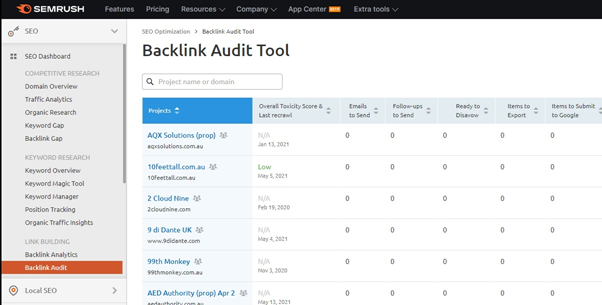There are billions of people watching online video content, and that number grows every year. Video content is a gold mine, but the strategy you’ll need to capture viewers will be different from the common SEO strategy.
SEO for video marketing still needs to be a part of your overall strategy. There are even some specific Youtube SEO techniques you can use to rank videos with Google.
We’ll share 5 ways you can optimize SEO for video using our toolkit.
What is Video SEO?
Video SEO is different from SEO for search engines. After Google, Youtube is the second most used search engine on the internet, and it has its own search rules, keywords, and search intent.
It helps that Google owns Youtube, so linking or associating your videos with your other content can help your SEO efforts.
The searches conducted through Youtube have a different intent, and the keyword research you do will reflect this difference. Search intent in this case would not be transactional; it would be more instructional.
Someone won’t want to know where to buy stir fry; they’ll want a video showing them how to make the quickest and easiest stir fry.
Alongside their selected video, Youtube will show them a stream of suggested videos. Youtube generates these videos based on search intent and the user’s viewing history.
If you can tap into a niche with your keyword research, your videos can have a long-lasting rank for suggested videos and continue to serve you.
SEO for video is specialized, so you can’t just use Google keywords and Youtube keywords interchangeably. While there will be cross-over, you do need to treat each search intent separately.
5 Best Practices for Video SEO
1. Video Thumbnails must be Eye-catching.
Much like a SERP, where people choose a link based on the meta description and their intent when people decide to watch a video, their choices are made mainly on the thumbnail image presented to them.
If you don’t engineer your thumbnails, then Youtube will present an image from the video. If you’re not careful, your thumbnail may be of someone pulling an awkward face, or an otherwise useless frame.
Not only do these thumbnails not represent what the video is about, but it is also unprofessional and will reflect poorly on your brand.

Here is a thumbnail for one of our videos. The video clearly stated what the topic is, the time stamp on the bottom right tells you how long the video is, and the image itself shows you who will be presenting. The content on the right is the text Google Bots can crawl, so it must be SEO compliant.
The Youtube Studio app can help you make thumbnails. You can choose 3 options from your video or choose to make your own.
Make your thumbnails relevant to the topic and eye-catching. Looking at the above image, you immediately know what the video is about, and the brilliant pops of yellow on the purple background are very eye-catching.
2. Your Title Tag Must Relate to the Video
For search intent, people will click on a video that matches what they’re looking for. If they click on your video and it doesn’t fulfill their search intent, they will click back and go elsewhere. Google, and Youtube, will notice this, and you might receive a drop in your search rankings.
Google will also penalize you if you try keyword baiting, where you deceive people into watching your video by tagging with irrelevant keywords.
Do some keyword research and write good copy for your title tags.
 You can see this title explains clearly what the video is about. And when you click through, you will have 13 minutes of great content all about doubling your blog traffic.
You can see this title explains clearly what the video is about. And when you click through, you will have 13 minutes of great content all about doubling your blog traffic. 3. Contextual Video Description
Your video description works much like a meta description. They should be relatively short and to the point with some keywords included.
Don’t stuff keywords into the description, and don’t lure people using a false description. Penalties will apply if you do.
Google bots search your video description, so make sure you’re serving up what the viewer wants when they’re searching for your content.

Using the example above, the description on the video’s page will encourage me to watch entire playlist with a link. There are also 2 more calls to action, including the important Subscribe button.

Include keywords from your research to work with that SEO campaign.
4. Tag your Video Appropriately
Video tags help categorize your video. When combined with the title and the description, video tags work in SEO harmony and can help boost your video up the search rankings.
Video tags help Google return videos that match search intent and can help users find similar videos by selecting the tags to search under.
To add a tag to your Video:
Sign in to your Youtube Studio. (You should have one if you have a Gmail account.) On the side menu on the right, select CONTENT and select the video you would like to add tags to. Add your tags.You can also do this via mobile.
5. Upload your Video’s Transcript
Transcribing your video is possibly the best tip we can give you to boost your video’s SEO. Transcripts comprise of the text that appears in your video’s closed captions. They also can appear in the comments below the video as well.
Naturally, you’re going to be talking about the main topic, which has been researched and includes keywords, so the transcript will have that. But there are more benefits to uploading your transcript, including:
Google crawls the text for SEO ranking. It allows people who have hearing difficulties to follow along with your video content as well.If you include the transcript in the description or comments section, you can add time markers to key points, so those who want answers immediately can jump to the timestamp and get the content they need.

In this video, we have included the transcript in the description. People will be able to copy and paste it for later and help Google scrape it and add value to our SEO.
Here’s an excerpt of the transcript:

How to use Semrush to Optimize your Video SEO
Planning an SEO video strategy can be similar to creating an on-page SEO strategy with written content. You can use the whole suite of Semrush tools to make sure the video you launch will have an impact, reach people, and rank.
Research your Visual Content using the Keyword Magic Tool
In the same way, you use Semrush to find questions and search intent to write articles, you can use the Keyword Magic tool to find questions to answer with your video content.
Understand the nature of video and how it serves a user’s search intent. Often they are looking for answers or instructions on how to do something. If you may have written articles about how to do keyword research, for example, you can also create a video that serves the same intent.
Create an instructional video with screen grabs and a step-by-step video of how to use Semrush to research keywords. You would need some slight variation in the titles and such, so you aren’t cannibalizing keywords.
Check Your Video Mark-up Using the Site Audit Tool
Mark-up is a part of your website schema that tells Google bots what your content is and how relevant that content is to search results. Using Content Hub techniques, with internal linking to similar content can help boost your mark-up, and this works the same way with video content.
If you have an instructional article, you can link to instructional videos to help with user experience and page authority.
To check to see if your mark-up and website schema works at your idea level, use the Site Audit tool. This tool checks for over 130 common website issues, including your use of mark-ups.
We have an excellent guide to performing SEO audits in 15 steps; check it out to learn more about how to use the Site Audit tool.
Monitor Backlinks Using the Backlink Audit Tool
Backlinks are a cornerstone of SEO, so backlinks to your video content are just as important as your regular written content. If the video is hosted on your website, use the Backlink Audit Tool to track and check on the health of any backlinks pointing to the page your video is featured on.

With this tool, you can identify and remove any bad links or check for any good or useful links to build relationships upon. You’ll want to grow your page authority with good backlinks.
Find out how you can audit and analyze your bank links in 5 easy steps.
Should You Host a Video on Your Website or on Youtube?
Where you host your video is also important for its SEO. Should you host it on your website or put it up on Youtube?
Hosting the Video on Your Site:
PROS
You maintain control of your intellectual property. Your website is your online real estate and you don’t have to agree to pages of terms and conditions for the use of your video. You can put your videos behind a paywall or subscription wall.CONS
You might need more server space than usual to host your video, especially if it’s long or a large file. You could spend extra money for more server space if you have a lot of your video content hosted on your site. Youtube has a lot of traffic, probably a lot more than your website does. You can miss out on that incidental reach, and ‘suggested next’ traffic. Youtube has a set of free tools you can use for video editing, and can help you add tags, transcripts, thumbnails, and more.Uploading your Video to Youtube
PROS
Youtube is the second largest search engine (next to Google) and is tailored for video. Youtube might suggest your video with their “Suggested Video” feature if your video is properly optimized, leading to more potential views.. Youtube can use your transcript to feed to Google Bots. It can also make an approximation of your transcript from the video you upload. You’ll be able to edit the transcript draft once available. Youtube’s thumbnail tools are an easy way to get a good thumbnail to show to potential viewers. Get followers easily, to your content through the Subscribe buttonCONS
You have to agree to Youtube’s terms and conditions before you upload content. Because it is Youtube, if they disagree with your content, they can pull it down. It’s harder to monetize your content for your target audience on Youtube. However, if you create a video and it goes viral, then there can be money to be made.Video Featured Snippets: Using Schema On Your Video
What kind of video are you posting? Are they instructional? Is it a how to guide or a recipe? How you optimize your content and construct your schema around your video helps them earn featured snippets.
Featured snippets on a SERP are where a person can get the information without clicking through. They’re also known as “zero click” search results.
Give Google as much information through the VideoObject code. Add a badge to help categorize your video, such as “home activities” for fun things to do at home.
You can also have key moments of the video featured, with exact start and end times.
Use the information available on Google Search Central to get started with snippets and schema surrounding your video.
Key Takeaways
High-speed mobile networks and more powerful smartphones allow users to watch the video anywhere, but you need to work on the SEO of your videos to cater to this market.
The SEO research you need for video is similar to but different from normal SEO research. Invest as much time and energy researching video SEO as you would with all your other keyword research. Get started with our guide on how to conduct Youtube keyword research.
Remember title tags, descriptions, and transcripts (all with keywords) can dramatically help with your video SEO rankings. Track the impact of your efforts with our Video Rank Tracker app to see if your rankings are moving positively.
Do video content and SEO interest you, even though you don’t have a channel yet? Check out our guide on how to create your own branded Youtube channel.
Innovative SEO services
SEO is a patience game; no secret there. We`ll work with you to develop a Search strategy focused on producing increased traffic rankings in as early as 3-months.
A proven Allinclusive. SEO services for measuring, executing, and optimizing for Search Engine success. We say what we do and do what we say.
Our company as Semrush Agency Partner has designed a search engine optimization service that is both ethical and result-driven. We use the latest tools, strategies, and trends to help you move up in the search engines for the right keywords to get noticed by the right audience.
Today, you can schedule a Discovery call with us about your company needs.
Source:





